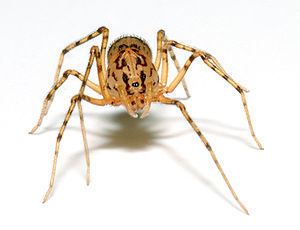Kingdom Animalia Subphylum Chelicerata Scientific name Haplogynae Rank Division | Phylum Arthropoda Order Araneae Clade Haplogynae Higher classification Araneomorphae | |
 | ||
Lower classifications Dysderidae, Tube‑dwelling spider, Tooth Cave spider | ||
The Haplogynae are a clade of araneomorph spiders, one of the two main groups into which the araneomorphs are divided.
Unlike the Entelegynae, they lack hardened (sclerotized) female genitalia (epigynes).
Most of the species within this group have six eyes, as opposed to most other spiders. Spiders in the genus Tetrablemma (Tetrablemmidae) have only four eyes, as do some members of the family Caponiidae; caponiids may even have only two eyes. However, spiders in the family Plectreuridae have the normal eight eyes.
Phylogeny
The Haplogynae are one of the two major groups into which the araneomorph spiders are divided, the other being the Entelegynae. In 2005 Coddington summarized the relationships of these groups as suggested by morphological phylogenetic studies:
Subsequent molecular phylogenetic studies have confirmed the monophyly of some of the groups suggested by morphological studies, while rejecting many others. The Austrochiloidea have been placed between the Haplogynae and the Entelegynae, rather than outside them both, rejecting Araneoclada as clade combining the Haplogynae and the Entelegynae:
A study published in 2015 suggests that two families formerly placed in the Haplogynae do not belong there. Filistatidae groups with Hypochilididae at the base of the Haplogynae; Leptonetidae is basal to the Entelegynae (Austrochiloidea was not included in this study). The similarity of some morphological features of Leptonetidae to those of entelegynes had already been noted.
One hypothesis for the internal phylogeny of the Haplogynae is shown below. It is based on Coddington's 2005 cladogram, with the addition of the new family Trogloraptoridae. Shading shows the families that were excluded in the 2015 phylogeny given above. Not all of the families shown below were included in that study, but the position of those that were is generally consistent with Coddington's (2005) cladogram.
